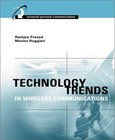Modulation and Coding Techniques in Wireless Communications

Book Details:
| Publisher: | Wiley |
| Series: | Wiley |
| Author: | Sergei Semenov |
| Edition: | 1 |
| ISBN-10: | 0470745053 |
| ISBN-13: | 9780470745052 |
| Pages: | 680 |
| Published: | Feb 21 2011 |
| Posted: | Nov 19 2014 |
| Language: | English |
| Book format: | |
| Book size: | 8.18 MB |
Book Description:
The high level of technical detail included in standards specifications can make it difficult to find the correlation between the standard specifications and the theoretical results. This book aims to cover both of these elements to give accessible information and support to readers. It explains the current and future trends on communication theory and shows how these developments are implemented in contemporary wireless communication standards.Examining modulation, coding and multiple access techniques, the book is divided into two major sections to cover these functions. The two-stage approach first treats the basics of modulation and coding theory before highlighting how these concepts are defined and implemented in modern wireless communication systems. Part 1 is devoted to the presentation of main L1 procedures and methods including modulation, coding, channel equalization and multiple access techniques. In Part 2, the uses of these procedures and methods in the wide range of wireless communication standards including WLAN, WiMax, WCDMA, HSPA, LTE and cdma2000 are considered.An essential study of the implementation of modulation and coding techniques in modern standards of wireless communication Bridges the gap between the modulation coding theory and the wireless communications standards material Divided into two parts to systematically tackle the topic - the first part develops techniques which are then applied and tailored to real world systems in the second part Covers special aspects of coding theory and how these can be effectively applied to improve the performance of wireless communications systems
Download Link:
Related Books:
Technology Trends in Wireless Communications
A guide to the technology details you need to know to prepare yourself and your organization for tomorrow's world of wireless multimedia. It includes in-depth discussions on topics in this area, including AAA, multiple access protocols, IPv6 and adaptive technologies. Such resource management strategies as power control, user admission techniques, and congestion control are explained....
Adaptive Signal Processing in Wireless Communications
Adaptive techniques play a key role in modern wireless communication systems. The concept of adaptation is emphasized in the Adaptation in Wireless Communications Series through a unified framework across all layers of the wireless protocol stack ranging from the physical layer to the application layer, and from cellular systems to next-generation wireless networks. This specific volume, Adaptive Signal Processing in Wireless Communications is devoted to adaptation in the physical layer. It gives an in-depth survey of adaptive signal processing techniques used in current and future generations of wireless communication systems. Featuring the work of leading international experts, it covers adaptive channel modeling, identification and equalization, a...
Physical Layer Security in Wireless Communications
Physical layer security has recently become an emerging technique to complement and significantly improve the communication security of wireless networks. Compared to cryptographic approaches, physical layer security is a fundamentally different paradigm where secrecy is achieved by exploiting the physical layer properties of the communication system, such as thermal noise, interference, and the time-varying nature of fading channels.Written by pioneering researchers, Physical Layer Security in Wireless Communications supplies a systematic overview of the basic concepts, recent advancements, and open issues in providing communication security at the physical layer. It introduces the key concepts, design issues, and solutions to physical layer securit...
2007 - 2021 © eBooks-IT.org



